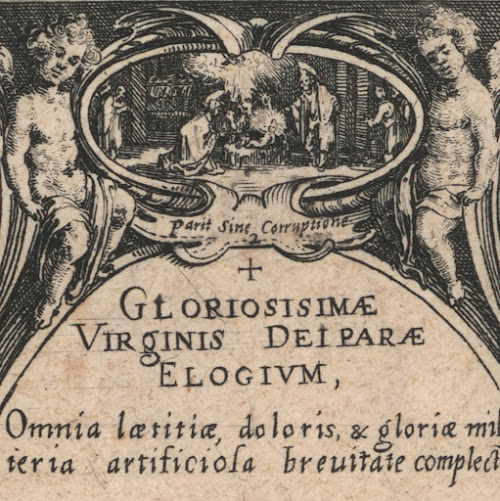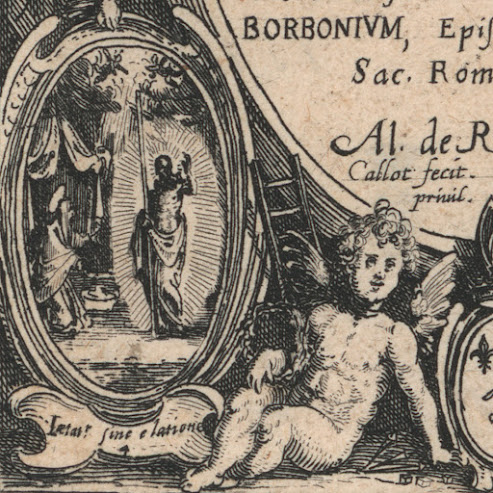Sometimes
when looking at the collectors’ stamps on the back of prints one’s mind takes a
metaphorical leap back in time to enter into the mindset and experiences of a
print’s previous owners. In the case of today’s etching—the frontispiece to “Gloriosisimæ
Virginis Dei Paræ Elogivm” (Praise the Most Glorious Virgin of God) by one of
the most famous of all printmakers, Jacques Callot—this tiny print was once owned
by a Hungarian nobleman with the name, Görgey, as the back show his estate-stamp
featuring his family’s coat-of-arms with the words below: “GÖRGEY/ HAGYATEK [i.e., his estate]”. Certainly, this is undoubtedly the stamp signifying
nobility as the “y” on the end of the name signifies this even beyond the arms
shown above it. Perhaps even more interestingly, however, is that the “y” at the end
of the name clarifies that the stamp was placed on this print before the
Hungarian revolution of 1848–49, as this date is when those of noble birth were
prudent to change the last letter of their name from “y” to “i”, hence this
collector's stamp is earlier than 1848. Although I do not have a strong grip on
possible collectors of Hungarian noble descent, I would like to believe (and I
may well be very wrong) that the stamp belongs to one
of the greatest generals of the Hungarian Revolutionary Army, Artúr Görgei or Artúr
Görgey (1818–1916)—the latter being his name at birth.
The
reason I mention all this detail is because my head is at the moment reeling
from the knowledge that next week I’ll be walking in the streets of Budapest
where this general earned his fame. In short, I’m going back to the hometown of
where this print rested for some of its life … wacko! See you in another week,
Budapest!
Also
on the back of this print is the delicately fine collector’s stamp of the Austrian
writer, Count Franz Jozef von Enzenberg (1802–1879) (Lugt 845). From reading
the account about this collector in Frits Lugt’s (2002) “Les Marques de Collections
de Dessins & d’Estampes” (p. 151) I understand that this collector amassed
pieces of what Lugt describes (in transl.) as “the greatest rarity” and owned
the Castle of Tratzberg in Tirol. He must have been a very focused and interesting
chap and I'm honoured to be briefly in his head!
Jacques Callot (1592–1635)
“Frontispiece ‘Gloriosissimæ’” (Lieure title) (aka “Frontispiece ‘Gloriosisimæ Virginis Dei Paræ Elogivm’” [Praise the Most Glorious Virgin of God]), c1625 (BM: 1621–1633), published by Israël Henriet (c1590–1661) with Royal privilege and designed for a publication written by Alphonse de Rambervillers (1552–1633) (as inscribed in plate), with a dedication to Henri de Bourbon, Duc de Verneuil (1601–1682).
The
Curator of the British Museum advises: “The production and publication line [were]
probably added by Henriet after Callot's death” (https://www.britishmuseum.org/collection/object/P_1861-0713-165).
Etching
on fine laid paper, trimmed close to the image borderline. Stamped verso with
the collector marks of Count Franz Jozef von Enzenberg (1802–1879) (Lugt
845) and the estate stamp of the Hungarian Nobleman, “[coat-of-arms]/ GÖRGEY/
HAGYATEK”—possibly Artúr Görgei/Görgey (1818–1916).
Size:
(sheet) 9.8 x 7.2 cm.
Lettered
in plate: (oval) “GLORIOSISIMÆ/ VIRGINIS DEI PARÆ ELOGIVM/ Omnia lœtitiœ,
doloris, & gloriœ mis-/ teria artificiola breuitate complectes./ …/ Ad
Illustrissimum & / Reuerendissimum Principem, Henricvm/ BORBONIVM,
Episcopum Metensem,/ Sac. Rom. Imp. P. etc./ Al. de Ramb. IC ’cecinit./ Callot fecit. Israël ex. cum/ priuil. Reg.”; each one
of the small oval scenes is captioned and numbered.
State
iii (of iii) with the addition of the text lines “Callot fecit. Israël ex. cum/
priuil. Reg.”
Lieure
512 iii (Jules Lieure 1989, “Jacques Callot: Catalogue Raisonné de l’Œuvre
Gravé, San Francisco, Alan Wofsy Fine Arts, pp. 47–48, cat. no. 509 3e);
Meaume 90.
The
British Museum offers the following description of this print: “Large oval
cartouche with engraved inscription, surrounded by six putti and five oval
medallions illustrated with scenes from the life of the Virgin: anti-clockwise,
birth of Christ. Virgin and St Joseph worshipping Christ Child, Christ on
Cross, Christ appearing to Virgin, and triumph of Virgin; with production and
publication detail. 1621/33 Etching” (https://www.britishmuseum.org/collection/object/P_X-4-36).
Condition:
a richly inked and well-printed (near faultless) impressions with no tears,
holes, abrasions, significant stains or foxing. Verso has ink stamps of two
collectors and remnants of previous mounting along with pencil and ink notations
by previous collectors.
I
am selling this superb impression of a small and rare etching for AU$322 in total
(currently US$214.81/EUR196.94/GBP172.97 at the time of posting this listing)
including postage and handling to anywhere in the world, but not (of course)
any import duties/taxes imposed by some countries.
If
you are interested in purchasing this tiny frontispiece by one of the major old
master printmakers, please contact me (oz_jim@printsandprinciples.com) and I
will send you a PayPal invoice to make the payment easy.
This print has been sold










No comments:
Post a Comment
Please let me know your thoughts, advice about inaccuracies (including typos) and additional information that you would like to add to any post.